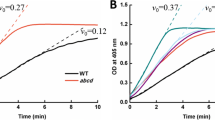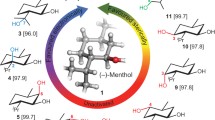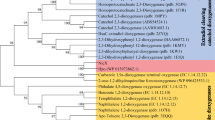Abstract
meta-Cleavage product (MCP) hydrolases (EC 3.7.1.9) can catalyze a specific C–C bond fission during the microbial aerobic degradation of aromatics. The previous studies on structure–function relationship of MCP hydrolases mainly focus on the active site residues by site-directed mutagenesis. However, the information about the role of the non-active-site residues is still unclear. In this study, a non-active-site residue Met148 of MCP hydrolase BphD was selected as the mutagenesis site according to the sequence alignments, structure superimpose and the tunnel analysis, which underwent the saturation mutagenesis resulting 19 mutants. The catalytic efficiencies of the mutants on 6-oxo-6-phenylhexa-2,4-dienoic acid (HOPDA) were all decreased compared with the wild-type one except for the M148D mutant. Especially, the M148P mutant exhibited 290-fold lower k cat/K m than that of the wild-type BphD. Transient kinetic analyses of M148P showed the reciprocal relaxation time corresponded to C–C bond cleavage and product release steps (9.6 s−1) was 4.08-fold lower than BphD WT (39.2 s−1). Tunnel cluster analysis of BphD WT, M148P and M148W demonstrated that only the bulky Trp148 could block tunnel T2 in the BphD WT, but it exhibited slight effects on the catalytic efficiency (0.94-fold of BphD WT). Therefore, product release was not the main reason for the efficiency decrease of M148P. On the other hand, molecular dynamics simulations on the BphD WT and BphD M148P in complex with HOPDA indicated that the dramatic decrease of the catalytic efficiencies of BphD M148P should be due to the unproductive binding of HOPDA. The study demonstrated the catalytic efficiency of MCP hydrolase can be engineered by modification of non-active site residue.






Similar content being viewed by others
References
Arenghi FL, Berlanda D, Galli E, Sello G, Barbieri P (2001) Organization and regulation of meta cleavage pathway genes for toluene and o-xylene derivative degradation in Pseudomonas stutzeri OX1. Appl Environ Microbiol 67:3304–3308
Bhowmik S (2008) Structural investigation into the mechanism of catalysis and inhibition of two carbon-carbon bond hydrolases. Dissertation, University of Purdue
Bhowmik S, Horsman GP, Bolin JT, Eltis LD (2007) The molecular basis for inhibition of BphD, a C–C bond hydrolase involved in polychlorinated biphenyls degradation: large 3-substituents prevent tautomerization. J Biol Chem 282:36377–36385
Brouk M, Derry NL, Shainsky J, Ben-Barak Zelas Z, Boyko Y, Dabush K, Fishman A (2010) The influence of key residues in the tunnel entrance and the active site on activity and selectivity of toluene 4-monooxygenase. J Mol Catal B: Enzymatic 66:72–80
Chovancová E, Pavelka A, Benes P, Strnad O, Brezovsky J, Kozlikova B, Gora A, Sustr V, Klvana M, Medek P, Biedermannova L, Sochor J, Damborsky J (2012) CAVER 3.0: A tool for analysis of transport pathways in dynamic protein structures. PLoS Comput Biol 8:e1002708
Chaloupková R, Sýkorová J, Prokop Z, Jesenská A, Monincová M, Pavlová M, Tsuda M, Nagata Y, Damborský J (2003) Modification of activity and specificity of haloalkane dehalogenase from Sphingomonas paucimobilis UT26 by engineering of its entrance tunnel. J Biol Chem 278:52622–52628
Diaz E (2004) Bacterial degradation of aromatic pollutants: a paradigm of metabolic versatility. Int Microbiol 7:173–180
Dodson GG, Lawson DM, Winkler FK (1992) Structural and evolutionary relationships in lipase mechanism and activation. Faraday Discuss 93:95–105
Fushinobu S, Saku T, Hidaka M, Jun SY, Nojiri H, Yamane H, Shoun H, Omori T, Wakaqi T (2002) Crystal structures of a meta-cleavage product hydrolase from Pseudomonas fluorescens IP01 (CumD) complexed with cleavage products. Protein Sci 11:2184–2195
Hernáez MJ, Andújar E, Ríos JL, Kaschabek SR, Reineke W, Santero E (2000) Identification of a serine hydrolase which cleaves the alicyclic ring of tetralin. J Bacteriol 182:5448–5453
Hess B, Kutzner C, van der Spoel D, Lindahl E (2008) GROMACS 4: Algorithms for highly efficient, load-balanced, and scalable molecular simulation. J Chem Theory Comput 4:435–447
Horsman GP, Bhowmik S, Seah SYK, Kumar P, Bolin JT, Eltis LD (2007) The tautomeric half-reaction of BphD, a C–C bond hydrolase. Kinetic and structural evidence supporting a key role for histidine 265 of the catalytic triad. J Biol Chem 282:19894–19904
Horsman GP, Ke J, Dai S, Seah SY, Bolin JT, Eltis LD (2006) Kinetic and structural insight into the mechanism of BphD, a C–C bond hydrolase from the biphenyl degradation pathway. Biochemistry 45:11071–11086
Humphrey W, Dalke A, Schulten K (1996) VMD: visual molecular dynamics. J Mol Graph 14:33–38
Jun SY, Fushinobu S, Nojiri H, Omori T, Shoun H, Wakaqi T (2006) Improving the catalytic efficiency of a meta-cleavage product hydrolase (CumD) from Pseudomonas fluorescens IP01. Biochim Biophys Acta 1764:1159–1166
Khajamohiddin S, Repalle ER, Pinjari AB, Merrick M, Siddavattam D (2008) Biodegradation of aromatic compound: an overview of meta-fission product hydrolases. Crit Rev Microbiol 34:13–31
Kikuchi Y, Yasukochi Y, Nagata Y, Fukuda M, Takaqi M (1994) Nucleotide sequence and functional analysis of the meta-cleavage pathway involved in biphenyl and polychlorinated biphenyl degradation in Pseudomonas sp. strain KKS102. J Bacteriol 176:4269–4276
Li BC, Yang GY, Wu L, Feng Y (2012) Role of the NC-loop in catalytic activity and stability in lipase from Fervidobacterium changbaicum. PLoS One 7:e46881–e46890
Li C, Li JJ, Montgomery MG, Wood SP, Bugg TD (2006) Catalytic role for arginine 188 in the C–C hydrolase catalytic mechanism for Escherichia coli MhpC and Burkholderia xenovorans LB400 BphD. Biochemistry 45:12470–12479
Li C, Hassler M, Bugg TD (2008) Catalytic promiscuity in the alpha/beta-hydrolase superfamily: hydroxamic acid formation, C–C bond formation, ester and thioester hydrolysis in the C–C hydrolase family. ChemBioChem 9:71–76
Li C, Montgomery MG, Mohammed F, Li JJ, Wood SP, Bugg TD (2005) Catalytic mechanism of C-C hydrolase MhpC from Escherichia coli: kinetic analysis of His263 and Ser110 site-directed mutants. J Mol Biol 346:241–251
Li JJ, Bugg TD (2007) Investigation of a general base mechanism for ester hydrolysis in C–C hydrolase enzymes of the alpha/beta-hydrolase superfamily: a novel mechanism for the serine catalytic triad. Org Biomol Chem 5:507–513
Malde AK, Zuo L, Breeze M, Stroet M, Poger D, Nair PC, Oostenbrink C, Mark AE (2011) An automated force field topology builder (ATB) and repository: version 1.0.0. J Chem Theory Comput 7:4026–4037
Nojiri H, Taira H, Iwata K, Morii K, Nam JW, Yoshida T, Habe H, Nakamura S, Shimizu K, Yamane H, Omori T (2003) Purification and characterization of meta-cleavage compound hydrolase from a carbazole degrader Pseudomonas resinovorans strain CA10. Biosci Biotechnol Biochem 67:36–45
Pavelka A, Chovancova E, Damborsky J (2009) HotSpot Wizard: a web server for identification of hot spots in protein engineering. Nucleic Acids Res 37:W376–W383
Pavlova M, Klvana M, Prokop Z, Chaloupkova R, Banas P, Otyepka M, Wade RC, Tsuda M, Nagata Y, Damborsky J (2009) Redesigning dehalogenase access tunnels as a strategy for degrading an anthropogenic substrate. Nat Chem Biol 5:727–733
Qu YY, Zhou H, Li A, Ma F, Zhou JT (2011) Nitroreductase activity of ferredoxin reductase BphA4 from Dyella ginsengisoli LA-4 by catalytic and structural properties analysis. Appl Microbiol Biotechol 89:655–663
Ruzzini AC, Ghosh S, Horsman GP, Foster LJ, Bolin JT, Eltis LD (2012a) Identification of an acyl-enzyme intermediate in a meta-cleavage product hydrolase reveals the versatility of the catalytic triad. J Am Chem Soc 134:4615–4624
Ruzzini AC, Horsman GP, Eltis LD (2012b) The catalytic serine of meta-cleavage product hydrolases is activated differently for C–O bond cleavage than for C–C bond cleavage. Biochemistry 51:5831–5840
Seah SYK, Ke JY, Denis G, Horsman GP, Fortin PD, Whiting CJ, Eltis LD (2007) Characterization of a C–C bond hydrolase from Sphingomonas wittichii RW1 with novel specificities towards polychlorinated biphenyl metabolites. J Bacteriol 189:4038–4045
Seah SYK, Terracina G, Bolin JT, Riebel P, Snieckus V, Eltis LD (1998) Purification and preliminary characterization of a serine hydrolase involved in the microbial degradation of polychlorinated biphenyls. J Biol Chem 273:22943–22949
Wilderman PR, Gay SC, Jang HH, Zhang Q, Stout CD, Halpert JR (2012) Investigation by site-directed mutagenesis of the role of cytochrome P450 2B4 non-active-site residues in protein–ligand interactions based on crystal structures of the ligand-bound enzyme. FEBS J 279:1607–1620
Zhou H, Qu YY, Kong CL, Wu YG, Zhu K, Yang J, Zhou JT (2012a) Promiscuous esterase activities of the C–C hydrolases from Dyella ginsengisoli. Biotechnol Lett 34:1107–1113
Zhou H, Qu YY, Shen E, Kong CL, Zhang XW, Ma Q, Zhou JT (2012b) Tuning the substrate selectivity of meta-cleavage product hydrolase by domain swapping. Appl Microbiol Biotechol. doi:10.1007/s00253-012-4405-5
Acknowledgments
The authors gratefully acknowledge the financial supports from the National Natural Science Foundation of China (No. 21176040; No. 51078054; No. 20923006) and the high performance computer cluster of Beijing Computing Center (BCC).
Author information
Authors and Affiliations
Corresponding author
Electronic supplementary material
Below is the link to the electronic supplementary material.
ESM 1
(PDF 191 kb)
Rights and permissions
About this article
Cite this article
Zhou, H., Qu, Y., Kong, C. et al. The key role of a non-active-site residue Met148 on the catalytic efficiency of meta-cleavage product hydrolase BphD. Appl Microbiol Biotechnol 97, 10399–10411 (2013). https://doi.org/10.1007/s00253-013-4814-0
Received:
Revised:
Accepted:
Published:
Issue Date:
DOI: https://doi.org/10.1007/s00253-013-4814-0




